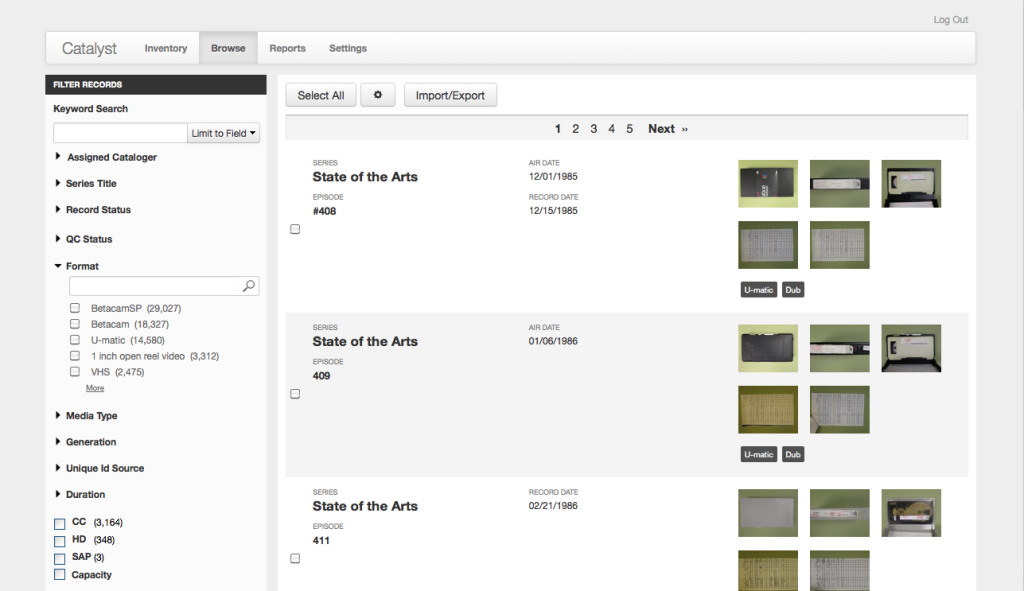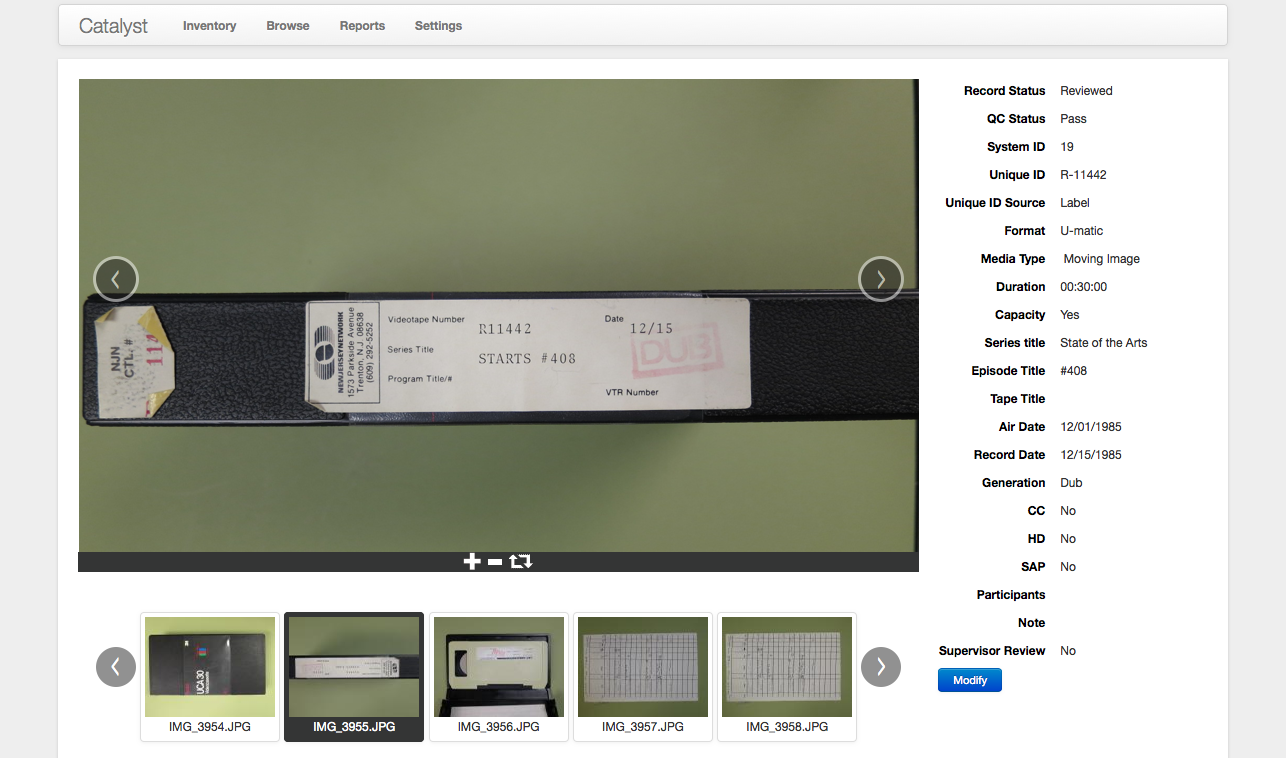The Things We Do — Catalyst Item Level Inventory
July 15, 2014
I’m experimenting with a new series here, tentatively title The Things We Do. In part inspired by Kevin Driedger (got it right this time!) 5 Days of Preservation. In part inspired by the fact that my family hasn’t a clue of what I actually do with my life (besides rock).

And in part inspired by the fact that even many of our colleagues don’t have a clear sense of the scope of work AVPreserve performs. To start off, of course I’m going to highlight myself, but in the future there will be much more interesting posts or interviews with the dynamic team (present company excluded) we have here.
**************************
There is a problem with processing audiovisual collections. And even though that starts with “P”, the problem is not pool. No, the problem is the incredible processing and reformatting backlog that afflicts a vast number of audiovisual collections held by archives, studios, broadcasters, businesses, governmental departments, independent producers, and any number of individuals or units that create or collect content.
Of course, processing backlogs are an issue across the board for archives, independent of media type. Why should we think that it’s a bigger problem with audiovisual collections than with paper. Well, a few reasons.
- Processing and preservation work has long been put off due to a lesser respect for a/v in comparison to paper.
- Processing and preservation work has long been put off due to lack of in-house expertise with the media and slower processing rates.
- Processing and preservation work has long been put off due to an incompatibility with professional practices developed for paper materials.
- Processing and preservation work has long been put off due to lack of technology for access available in-house.
- Preservation — read, reformatting — is an absolute necessity for continued survival of materials that face severe degradation and obsolescence issues.
- Reasonable preservation planning cannot occur without some degree of processing in order to determine what formats one has and what content is important.
Let me underscore those last facts. Reformatting of audiovisual materials is an integral act of preservation and access, an act that must be repeated periodically due to the relatively short lifespans of the media and the impact of obsolescence. Much of the digitization of paper is done primarily for access purposes. For audiovisual materials digitization or other reformatting is a matter of survival.
Second, as I have long been writing about in regard to minimal processing in audiovisual collections, some degree of item level accounting must be performed in order to select items for preservation, plan budgets, and manage the preservation project. The other option is to just digitize everything. In some situations this works. in others it is impractical, unaffordable, and unnecessary. However, some reformatting must be done to properly care for a collection, and you must know what you have in order to prioritize and move ahead.
To address the issues of massive backlogs and lack of intellectual control over audiovisual collections, we developed the Catalyst Inventory process. Catalyst is an innovative method of creating item-level inventories of audiovisual collections. The process uses a team of photographers onsite to image each item in a collection, capturing all information-carrying sides of a cassette/reel/disk, its housing, and any paper inserts. The photos are uploaded daily to our central server where they are sorted into item records and fields for Unique ID, Location, and Format are automatically generated.
After this the database records are immediately accessible by a team of offsite catalogers who use the images to enter further metadata. Taking advantage of automated processing and minimal datasets, even a small team can work through hundreds or thousands of items a day. Catalyst data can be exported to generate reports for preservation planning and selection, or to become the basis of a finding aid or more complete catalog record.
The benefit of the photos is that materials can be searched for and reviewed without the need to pull tapes until correct items are identified, minimizing handling and staff time. Also further descriptive cataloging can take place at a more reasonable pace or after reformatting has been completed. The benefit of the Catalyst approach and software is that it quickly overcomes backlogs, is specialized for audiovisual collections, and provides a flexible, immediately useable dataset.
- Catalyst is efficient. One imager can photograph 300-400 items per day. One cataloger can generate records for 150-200 items per day.
- Catalyst saves people’s time and backs. Records can be searched and the images can be reviewed to determine if the item is the correct one without having to pull boxes off the shelf.
- Catalyst is extendable. Minimal datasets are focused on technical metadata and basic description that will support selection and planning. However, project specific fields can be added, the data is easily exportable in XML or CSV for import into other systems, and deeper descriptive cataloging can take place on a longer time period through further use of the photos or access copies of media post-digitization.
- Catalyst is fast. Immediately upon upload each item automatically generates an ID, a record of the item’s physical location, and a record of its format. Even without further cataloging you have a useable set of records to browse (with images) and begin basic planning.
This approach has been used on a number of projects, including an inventory of the New Jersey Network (NJN) Library (case study forthcoming). NJN is the former public broadcasting station for New Jersey that was shut down by the State in 2011. We performed the inventory of their collection of close to 120,000 audio, video, and film items in about 3-4 months time. This led directly to the ability to select and locate items when the opportunity to digitize 1700 hours of content for preservation suddenly arose. NJN is currently putting together funding and a preservation plan to reformat more of their historic 40-year collection of news and and programming about New Jersey, an effort that will be supported by the inventory.
Catalyst was birthed neither out of my skull nor my thigh unmediated, but was rather developed out of years of performing collection assessments and becoming familiar with the many ways that audiovisual collections are arranged and stored, as well as what degree of annotation (or lack of annotation) the items typically present. Within collections, archives can be overwhelmed by trying to get a grasp on the questions of What do we have, Where is it, and Where do we start, in addition to the question of How do we even start to figure that out given the circumstances of budgets, timelines, lack of playback, and lack available documentation.
As a consultant I can’t say that I do direct conservation work, processing, or collection management to preserve and make accessible a collection. However, this is the type of thing I do, to develop solutions, collaborate, communicate, share experience with organizations, or manage resources to help them move to the next step of what they need to do.
The Catalyst Inventory software is currently only available as part our assessment and inventory services, but you can contact me at josh{at}avpreserve{dot}com with any questions or to discuss it.

